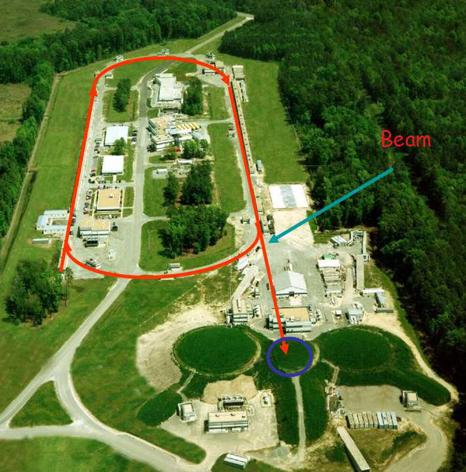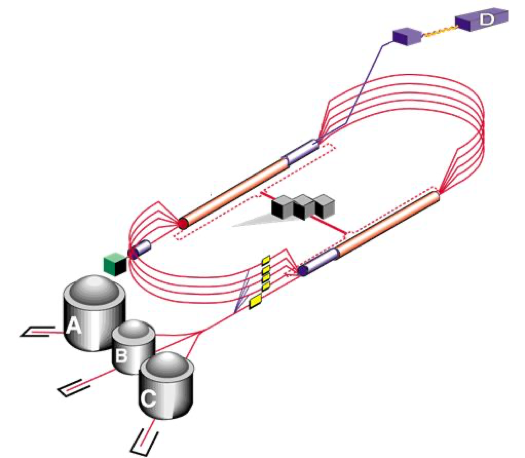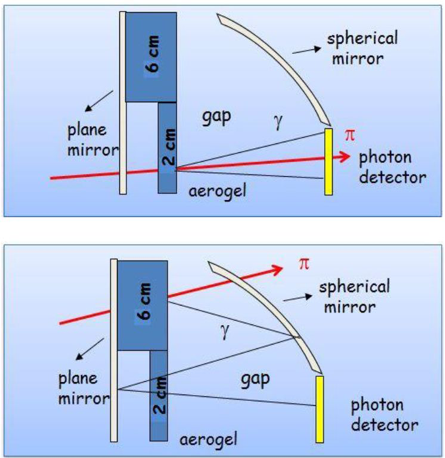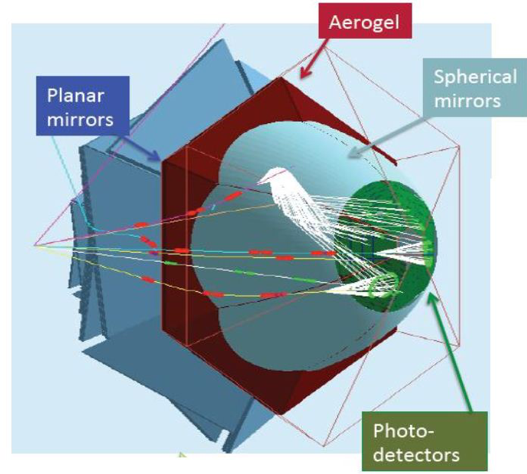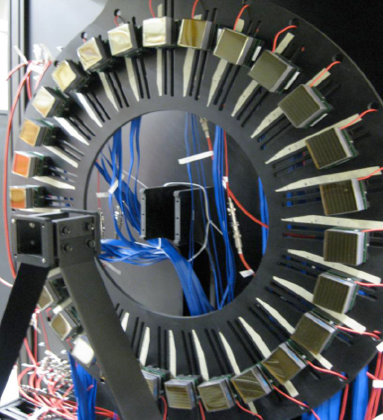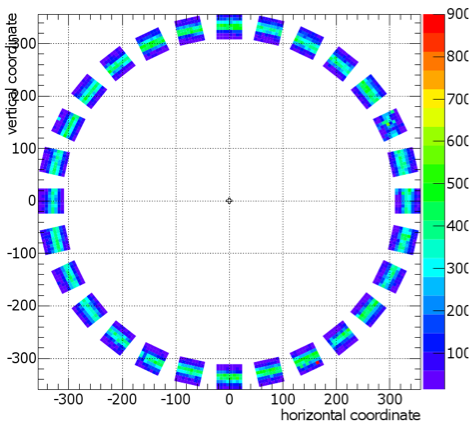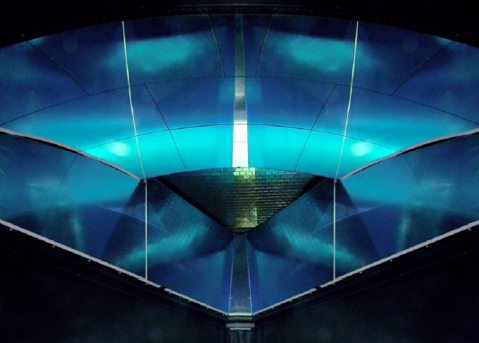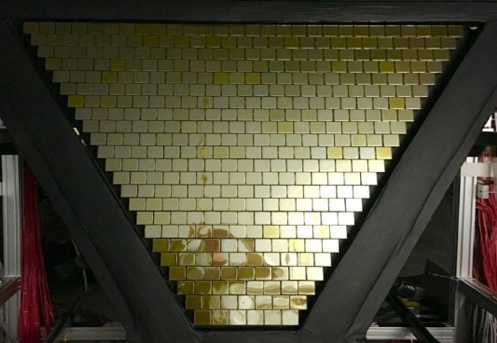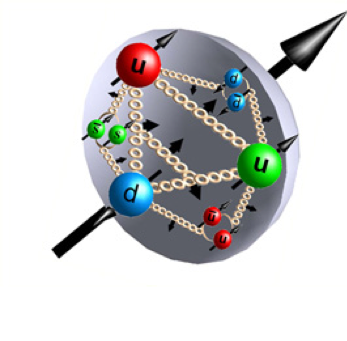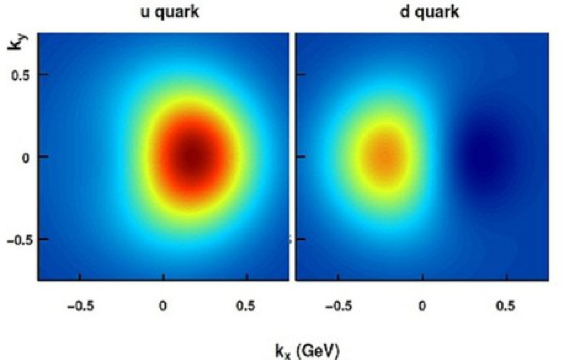The Ferrara research activity at Thomas Jefferson Lab (JLab)
The Ferrara research activity at Thomas Jefferson Lab (JLab)
| Research Group (staff only) |
| Dr. Marco Contalbrigo (National Coordinator) |
| Prof. Paolo Lenisa |
| Prof. Giuseppe Ciullo |
| Dr. Luciano L. Pappalardo |
The Thomas Jefferson National Accelerator Facility (JLab) is a United States Department of Energy (DOE) laboratory dedicated to the study of nuclear and sub-nuclear physics. The laboratory, located in Newport News (Virginia), is equipped with an intermediate energy (up to 12 GeV) electron accelerator (CEBAF) and four experimental halls, A, B C and D (figure 1). The primary goal of the experiments at Jlab is to study the dynamics and internal structure of hadrons and nuclei through the scattering of (longitudinally polarized) electrons against (polarized and unpolarized) nuclear targets. The Italian JLab collaboration, consisting of more than 50 physicists and engineers, is heavily involved in the realization of a vast research program in the field of hadronic physics. The areas of major interest are: form factors of nucleons and nuclei; nucleon structure functions; weak electron-nucleon interactions, meson spectroscopy; interaction of hadrons in (hyper)nuclei and search of new physics beyond the Standard Model. The experimental activity is supported by a large community of theoreticians, who collaborate in strong synergy with the experimentalists in the identification of the relevant physical observables to be measured and in the physical interpretation of the experimental results
Figure 1: View of the CEBAF accelerator facility.
The CLAS12 RICH detector
The Ferrara group involved in the JLab activities include experimental physicists who have been active for a long time in the study of the nucleon structure by means of experiments with polarized beams and targets (HERMES and JEDI experiments). Specifically, the group is actively involved in the CLAS12 physics program. The CLAS12 spectrometer (figure 2), installed in Hall B, is composed of a forward detector for the identification of the high-energy particles produced in the scattering of the 12 GeV beam electrons from various nuclear targets and a central detector for detection of the recoil particles. The forward detector, immersed in a toroidal magnetic field, is divided into 6 azimuthal sectors, each operating as an independent detector, and allows to discriminate with high efficiency the scattered electrons from the pions produced in the processes.
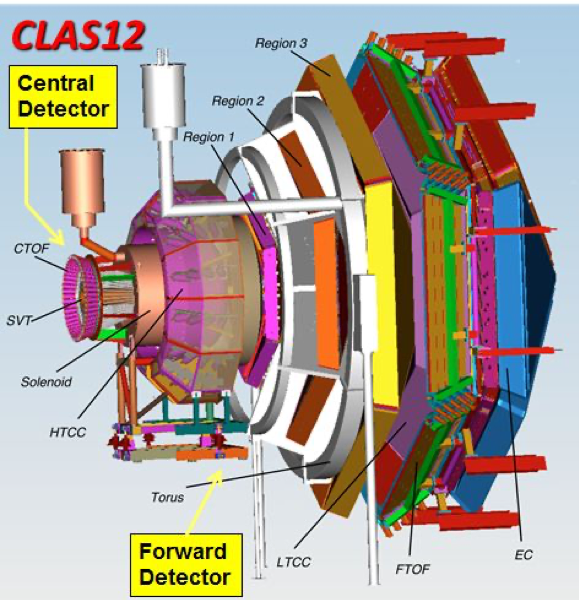
Figure 2: Scheme of the CLAS12 spectrometer in Hall B.
In its original configuration CLAS12 could not allow an adequate separation between pions and kaons in the 3-8 GeV/c momentum range. As a consequence, the realization of a RICH detector (Ring Imaging CHerenkov detector) was proposed, which was eventually constructed and installed with an important contribution of the Italian groups, and in particular of the Ferrara group. The RICH, in the proximity focusing configuration, is composed of three main elements: a radiator material through which the charged particles produce a Cherenkov light cone, a region (gap) where photons propagate, and a photon detector where the Cherenkov photons are detected forming characteristic rings of different radius (depending on the type of charged particle). The photon detector consists of an array of 400 Multi-Anode Photomultiplier Tubes per sector. The constraints imposed by the predefined geometry of the CLAS12 spectrometer resulted in the choice of a hybrid solution, in which part of the photons are revealed directly and part are revealed after a double reflection through a system of mirrors (one planar and one elliptical), as illustrated in Figure 3.
Among the various activities related to the RICH project, the Ferrara group has been also involved in the optical characterization of the radiator material. Based on the indications from Monte Carlo simulations, the aerogel was chosen as a radiator material (Figure 4). Aerogel is a solid gel of air and quartz, whose refractive index (n=1.05) ensures a good separation between pions and kaons in the desired momentum range.
Figure 3: Schematic view of the RICH detector geometry and working principle.
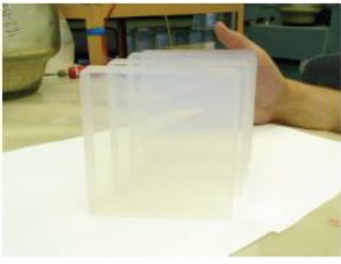
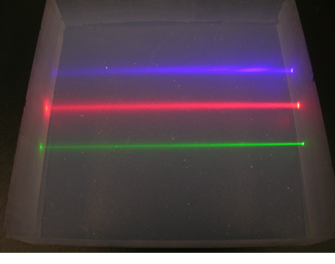
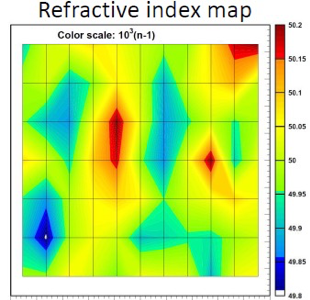
Figure 4: Aerogel tiles (left). By using lasers of different frequency (center) it is possible to map the refractive index uniformity for each tile (right) and to study the chromatic dispersion. Other optical properties (transmittance, scattering length, etc.) have been studied by means of a high-precision spectrophotometer.
Before the construction and commissioning of the first sector of the RICH detector (January 2019), several prototypes have been tested in dedicated test-beams at CERN and Laboratori Nazionali di Frascati. One of such prototypes is shown in Figure 5 together with a typical Cherenkov ring acquired during the test-beam. Figure 6 shows the first RICH sector before installation in CLAS12.
Figure 5: The RICH prototype tested at CERN, consisting of an array of 28 Multi-Anode photomultipliers, and an example of Cherenkov ring acquired during the test-beam.
Figure 6: The first sector of the RICH detector before installation on the CLAS12 spectrometer.
The 3-Dimensional structure of nucleons
The RICH detector, necessary for the identification of charged hadrons (pions, kaons and protons) in a wide momentum range, constitutes an essential ingredient for the realization of the rich physics program related to the study of the internal structure of the nucleon in deep inelastic scattering processes. In this regard, the Ferrara group is also promoter of several experimental proposals for CLAS12 experiments aimed at understanding the mechanisms that regulate the dynamics of quarks and gluons in the confinement regime of QCD. These studies will allow to obtain a three-dimensional mapping of the nucleon structure (“nucleon tomography”, Figure 7) using the measurement of two new and more general classes of parton distribution functions (PDFs): the TMDs and the GPDs, respectively sensitive to the transverse momentum and the transverse spatial coordinates of quarks.
Figure 7: Left: Schematic view of the complex internal structure of the proton in terms of quarks and gluons. Right: An example of nucleon tomography in momentum space for up and down quarks.
TMDs (Transverse Momentum Dependent PDFs) have been introduced historically to interpret the large azimuthal asymmetries observed in hadronic reactions with transversely polarized proton targets. These measurements revealed the existence of very large spin asymmetries (with amplitudes up to 40%!) in polarized proton-proton collisions in a wide range of energies (from a few GeV up to 500 GeV), in contrast to the belief that these asymmetries must be highly suppressed. These observations suggested the existence of new, unexpected properties of the nucleon structure, such as appreciable spin-orbit couplings associated with the transverse momentum of the quarks. To take into account these effects, new distribution functions sensitive to the quark transverse momentum (the TMDs) have been introduced in the last decades. Through the inclusion of the transverse degree of freedom (that has been neglected until recently) these functions can investigate possible connections between the motion of the partons, their orbital angular momentum, their spin and the spin of the nucleon. All these effects are inaccessible with the traditional framework, based solely on the collinear PDFs.
The 12 GeV physics program at Jefferson Lab will allow to study TMDs in semi-inclusive deep-inelastic-scattering processes (Figure 8 left) where, in addition to the dscattered electron, one or more hadrons are detected in the final state, with an accuracy never reached and in a kinematic domain (valence region) where the effects due to the transverse spin and the spin-orbit coupling play an important role (figure 8 right). The key elements for the realization of these measurements are the use of longitudinally and transversely polarized targets and polarized beams, associated with a large acceptance detector able to efficiently identify different types of hadrons in the final state.
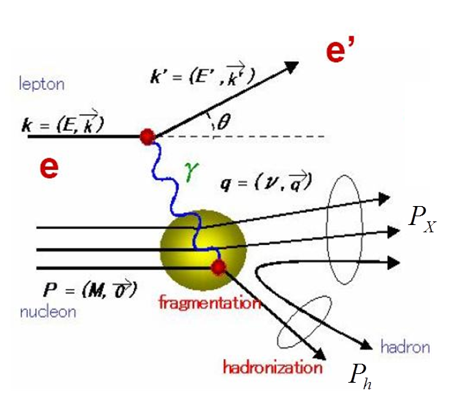
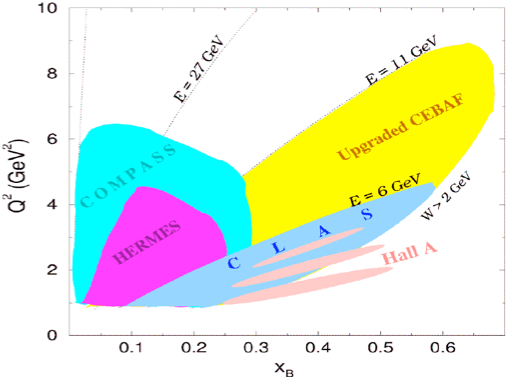
Figure 8: Left: Schematic representation of the semi-inclusive deep-inelastic scattering process. Right: Kinematic plane in the two variables x_B and Q^2. The kinematic coverage of the JLab experiments at 6 and 12 GeV is compared with that of the HERMES and COMPASS experiments.
A complementary approach to the study of the 3D structure of the proton is that of the GPDs (Generalized Parton Distributions). GPDs provide a generalized representation of the hadronic structure as they encode the information inherent to the standard parton distribution functions (PDFs) and to the electromagnetic form factors. The GPDs allow to study an innovative and essential aspect of the nucleon structure, i.e. the location of the partons in the plane transverse to the direction of motion and its correlation with their longitudinal momentum. This correlation allows to obtain tomographic images of the nucleon structure (Figure 9) analogous to the tomography used in medical diagnostics.
GPDs are typically studied through exclusive processes, where the nucleon remains intact and the final state is fully reconstructed. Among them, the main processes are DVCS (Deeply-Virtual Compton Scattering) and DVMP (Deeply-Virtual Meson Production). If, on the one hand, DVCS is the most easily interpreted channel in terms of GPDs, DVMP provides information dependent on the flavor of the constituent quarks. Both of these processes are being studied in detail at CLAS12
The possibility to describe the longitudinal momentum distributions at a given transverse localization is an essential prerequisite for studying the so-called Ji relation, which connects a certain combination of GPDs to the total angular momentum of the partons in the nucleon. From this quantity it is possible to extract the orbital angular momentum of the quarks, which up to now has never been measured and which constitutes a fundamental element for understanding the spin structure of the proton.
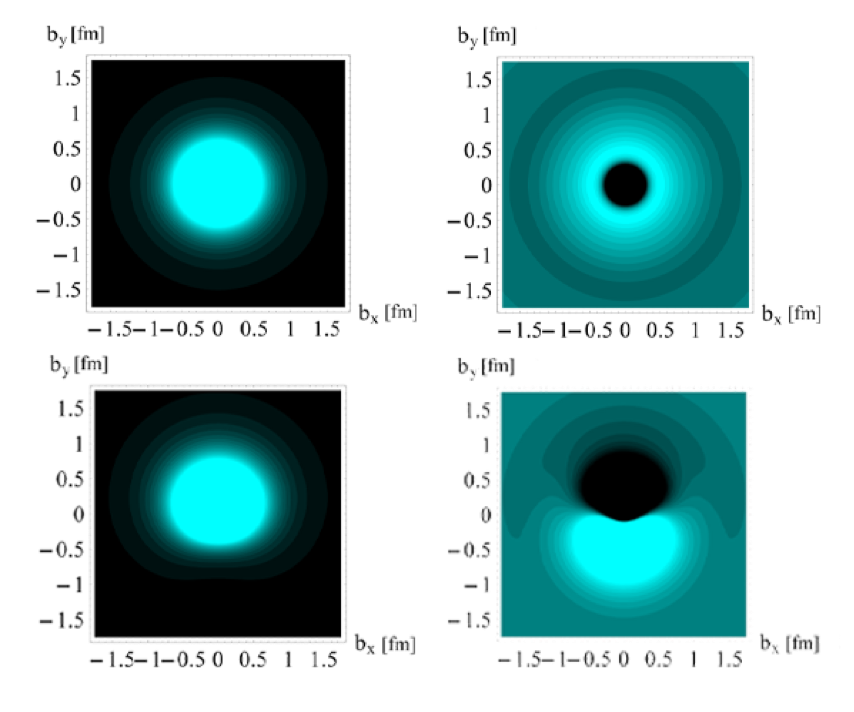
Figure 9: Nucleon tomography in coordinate space.

